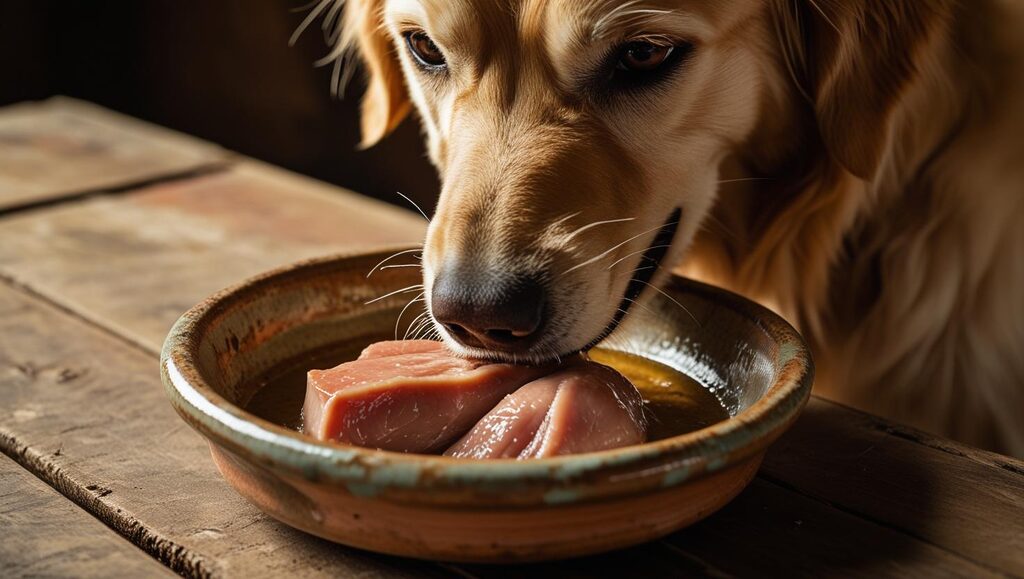Around the World in 50 Bites: A Cultural Journey of Meat Proteins for Your Beloved Dog

Your furry best friend deserves more than the same old kibble routine.
Dogs across different cultures have thrived on diverse protein sources for thousands of years. From the reindeer-fed sled dogs of Alaska to the kangaroo-loving working dogs of Australia, our canine companions have always adapted to local food sources.
This comprehensive guide explores 50 authentic meat proteins from around the globe. Each protein tells a story of cultural heritage, traditional dog feeding practices, and nutritional wisdom passed down through generations.
Ready to embark on this delicious journey? Let’s explore how different cultures have nourished their four-legged family members throughout history.
Table of contents
- Wild Game Proteins – Traditional Hunting Heritage
- Venison – North American Native Traditions
- Wild Boar – European Forest Traditions
- Elk – Canadian Indigenous Wisdom
- Rabbit – French Countryside Heritage
- Moose – Alaskan Wilderness Traditions
- Caribou – Arctic Indigenous Heritage
- Wild Duck – Wetland Hunter Traditions
- Pheasant – English Manor Traditions
- Wild Turkey – American Woodland Heritage
- Bear – North American Mountain Heritage
- Aquatic & Seafood Proteins – Maritime Heritage
- Fresh Sardines – Mediterranean Coastal Life
- Salmon – Pacific Northwest Indigenous Traditions
- Mackerel – North Atlantic Maritime Heritage
- Tuna – Pacific Deep Ocean
- Octopus – Mediterranean Coastal Heritage
- Crab Meat – Alaskan Waters
- Lobster – Maine Coast Heritage
- Shrimp – Gulf Waters Heritage
- Anchovies – Spanish Waters Heritage
- Mussels – European Coastal Heritage
- unique Land Animals – Global Adventure
- Kangaroo – Australian Outback Tradition
- Ostrich – African Savanna Heritage
- Bison – Great Plains Native Heritage
- Yak – Tibetan Highland Heritage
- Reindeer – Arctic Circle Traditions
- Alpaca – Peruvian Highland Heritage
- Camel – Arabian Desert Heritage
- Water Buffalo – Asian Marshland Heritage
- Llama – Bolivian Altiplano Heritage
- Emu – Australian Ranch Heritage
- Organ Meats – Cultural Nutritional Wisdom
- Beef Heart – Argentine Gaucho Heritage
- Chicken Liver – Global Farm Heritage
- Duck Gizzards – Asian Culinary Heritage
- Lamb Kidney – Mediterranean Shepherd Heritage
- Pork Liver – European Farm Heritage
- Turkey Neck – Heritage Breed Tradition
- Beef Tongue – Grass-Fed Heritage
- Venison Liver – Hunter Heritage
- Goose Liver – European Holiday Heritage
- Lamb Heart – Pastoral Heritage
- Poultry Varieties – Heritage Breed Traditions
- Guinea Fowl – African Traditional Heritage
- Squab – Urban Loft Heritage
- Goose – European Holiday Heritage
- Cornish Game Hen – Specialty Farm Heritage
- Duck – Asian Wetland Heritage
- Quail – Mediterranean Hunt Heritage
- Partridge – English Countryside Heritage
- Pigeon – Urban Survival Heritage
- Grouse – Highland Heritage
- Peacock – Royal Heritage
- Safety Guidelines for All Meat Proteins
- Frequently Asked Questions
- Conclusion: A World of Flavors Awaits
Wild Game Proteins – Traditional Hunting Heritage
Venison – North American Native Traditions
Cultural Heritage: Native American people have shared venison with their dogs for over 10,000 years. This practice strengthened the human-dog bond essential for survival in harsh wilderness conditions.
Flavor Profile: Rich, lean meat with an earthy taste that triggers ancestral hunting instincts. Dogs instinctively recognize this as premium nutrition.
Nutritional Benefits: Exceptionally high in protein (30g per 100g) and iron. Studies from the American Veterinary Medical Association show venison provides 25% more protein than conventional beef..
What to Serve With: Sweet potato mash, wild rice, or pumpkin puree for digestive support.
Portion Guidelines: 2-3 oz for small dogs (under 25 lbs), 4-6 oz for medium dogs (25-60 lbs), 6-8 oz for large dogs (over 60 lbs).
Wild Boar – European Forest Traditions
Cultural Heritage: German and French hunters have fed wild boar to their hunting dogs since medieval times to develop courage and stamina.
Flavor Profile: Intensely rich and robust with a slightly sweet undertone that active dogs crave.
Nutritional Benefits: Higher protein than domestic pork with natural zinc and selenium for immune support.
What to Serve With: Roasted root vegetables like carrots and parsnips, or brown rice for energy.
Portion Guidelines: 1-2 oz for small dogs, 3-4 oz for medium dogs, 4-6 oz for large dogs (rich protein, smaller portions).
Elk – Canadian Indigenous Wisdom
Cultural Heritage: First Nations peoples shared elk meat with sled dogs during long winter journeys for sustained energy.
Flavor Profile: Clean, mild gamey taste that’s less intense than venison with tender texture.
Nutritional Benefits: Contains natural CoQ10 for heart health and exceptional amino acid profile.
What to Serve With: Quinoa, steamed broccoli, or mashed butternut squash for balanced nutrition.
Portion Guidelines: 3-4 oz for small dogs, 5-7 oz for medium dogs, 7-10 oz for large dogs.
Rabbit – French Countryside Heritage
Cultural Heritage: French farm dogs have enjoyed rabbit as regular protein for centuries in rural communities.
Flavor Profile: Delicate, mild, and slightly sweet – perfect for dogs with sensitive stomachs.
Nutritional Benefits: Hypoallergenic protein that’s easily digestible and ideal for food allergies.
What to Serve With: White rice, boiled potatoes, or steamed green beans for gentle digestion.
Portion Guidelines: 2-3 oz for small dogs, 4-5 oz for medium dogs, 6-8 oz for large dogs.
Moose – Alaskan Wilderness Traditions
Cultural Heritage: Alaskan mushers fed moose meat to sled dogs for grueling Iditarod-style journeys.
Flavor Profile: Rich, gamey flavor more intense than elk with satisfying, robust taste.
Nutritional Benefits: Extremely high protein (32g per 100g) with natural iron and B-vitamins.
What to Serve With: Oatmeal, sweet potato, or wild blueberries for sustained energy.
Portion Guidelines: 2-3 oz for small dogs, 4-6 oz for medium dogs, 6-9 oz for large dogs.
Caribou – Arctic Indigenous Heritage
Cultural Heritage: Inuit peoples shared caribou with their dogs for thousands of years in Arctic survival partnerships.
Flavor Profile: Mild, sweet gamey flavor with tender texture and clean wild undertones.
Nutritional Benefits: Lean protein with high iron and natural omega-3s from wild Arctic diet.
What to Serve With: Arctic berries, barley, or roasted squash for cold-weather nutrition.
Portion Guidelines: 3-4 oz for small dogs, 5-7 oz for medium dogs, 7-10 oz for large dogs.
Wild Duck – Wetland Hunter Traditions
Cultural Heritage: North American waterfowl hunters shared wild duck with retriever breeds for centuries.
Flavor Profile: Rich, succulent flavor with natural oils creating irresistible aroma.
Nutritional Benefits: High protein and healthy fats, plus natural selenium from aquatic diet.
What to Serve With: Wild rice, cranberries, or steamed asparagus for wetland-inspired meals.
Portion Guidelines: 2-3 oz for small dogs, 3-5 oz for medium dogs, 5-7 oz for large dogs.
Pheasant – English Manor Traditions
Cultural Heritage: English sporting estates shared pheasant with pointer and setter breeds for field work.
Flavor Profile: Lean, mildly gamey with delicate texture and hints of nuttiness.
Nutritional Benefits: High-quality protein with natural phosphorus for strong bones and teeth.
What to Serve With: Mashed turnips, pearl barley, or roasted Brussels sprouts for English countryside flavors.
Portion Guidelines: 2-3 oz for small dogs, 4-5 oz for medium dogs, 6-8 oz for large dogs.
Wild Turkey – American Woodland Heritage
Cultural Heritage: American settlers shared wild turkey with dogs during autumn woodland hunts.
Flavor Profile: Lean, intensely flavored meat much richer than domestic turkey.
Nutritional Benefits: Lower fat than domestic turkey with higher protein concentration.
What to Serve With: Cranberry sauce (sugar-free), acorn squash, or corn kernels for Thanksgiving vibes.
Portion Guidelines: 3-4 oz for small dogs, 5-7 oz for medium dogs, 7-10 oz for large dogs.
Bear – North American Mountain Heritage
Cultural Heritage: Mountain trappers shared black bear meat with tracking dogs for wilderness survival.
Flavor Profile: Rich, dense flavor similar to beef but with deeper wild undertones.
Nutritional Benefits: High protein with natural fats and minerals from omnivorous diet.
What to Serve With: Wild mushrooms, root vegetables, or brown rice for mountain-inspired meals.
Portion Guidelines: 1-2 oz for small dogs, 2-4 oz for medium dogs, 4-6 oz for large dogs (very rich).
Aquatic & Seafood Proteins – Maritime Heritage
Fresh Sardines – Mediterranean Coastal Life
Cultural Heritage: Greek and Italian fishermen shared sardines with their dogs for over 2,000 years.
Flavor Profile: Mild, briny sweetness with natural oils creating irresistible aroma.
Nutritional Benefits: Omega-3 powerhouse (1.8g per serving) for coat condition and inflammation reduction.
What to Serve With: Olive oil drizzle, steamed zucchini, or Mediterranean herbs like parsley.
Portion Guidelines: 1-2 whole sardines for small dogs, 2-3 for medium dogs, 4-5 for large dogs.
Salmon – Pacific Northwest Indigenous Traditions
Cultural Heritage: Pacific Northwest groups shared salmon with dogs during annual runs for thousands of years.
Flavor Profile: Rich, buttery flavor with firm texture that dogs find absolutely irresistible.
Nutritional Benefits: Premium omega-3 source with astaxanthin for antioxidant protection.
What to Serve With: Cedar plank essence, wild rice, or steamed kale for Pacific Northwest authenticity.
Portion Guidelines: 2-3 oz for small dogs, 4-6 oz for medium dogs, 6-8 oz for large dogs.
Mackerel – North Atlantic Maritime Heritage
Cultural Heritage: Scottish and Norwegian fishermen fed mackerel to dogs during long sea voyages.
Flavor Profile: Rich, bold flavor with meaty texture satisfying hearty appetites.
Nutritional Benefits: High protein and omega-3 fatty acids supporting joint health in working breeds.
What to Serve With: Oats, seaweed flakes, or steamed cabbage for maritime nutrition.
Portion Guidelines: 1-2 oz for small dogs, 3-4 oz for medium dogs, 4-6 oz for large dogs.
Tuna – Pacific Deep Ocean
Cultural Heritage: Pacific island communities shared fresh tuna with their fishing companion dogs.
Flavor Profile: Meaty, rich flavor with firm texture and bold oceanic depth.
Nutritional Benefits: High protein with selenium and omega-3s for antioxidant protection.
What to Serve With: Seaweed salad, coconut flakes, or tropical fruits like mango.
Portion Guidelines: 2-3 oz for small dogs, 4-5 oz for medium dogs, 6-7 oz for large dogs.
Octopus – Mediterranean Coastal Heritage
Cultural Heritage: Greek and Italian fishermen shared octopus with coastal dogs for generations.
Flavor Profile: Mild, slightly sweet flavor with unique chewy texture.
Nutritional Benefits: High protein with natural taurine and marine minerals for heart health.
What to Serve With: Lemon juice, roasted red peppers, or Mediterranean cucumber.
Portion Guidelines: 1-2 oz for small dogs, 2-3 oz for medium dogs, 3-4 oz for large dogs.
Crab Meat – Alaskan Waters
Cultural Heritage: Alaskan coastal communities shared crab with their working dogs during fishing seasons.
Flavor Profile: Sweet, delicate flavor with tender, flaky texture naturally appealing to dogs.
Nutritional Benefits: High-quality protein with natural minerals and omega-3 fatty acids.
What to Serve With: Kelp noodles, steamed corn, or Arctic berries for coastal Alaska vibes.
Portion Guidelines: 1-2 oz for small dogs, 2-4 oz for medium dogs, 4-6 oz for large dogs.
Lobster – Maine Coast Heritage
Cultural Heritage: Maine lobstermen traditionally shared lobster scraps with their dock dogs.
Flavor Profile: Sweet, rich flavor with tender meat that’s luxurious and appealing.
Nutritional Benefits: Complete protein with natural minerals and healthy fats.
What to Serve With: Butter lettuce, steamed potatoes, or fresh dill for New England coastal dining.
Portion Guidelines: 1-2 oz for small dogs, 2-3 oz for medium dogs, 3-5 oz for large dogs.
Shrimp – Gulf Waters Heritage
Cultural Heritage: Gulf Coast shrimpers shared fresh shrimp with their boat dogs during harvest season.
Flavor Profile: Sweet, mild flavor with firm texture and natural oceanic sweetness.
Nutritional Benefits: Lean protein with natural iodine and minerals for thyroid health.
What to Serve With: Brown rice, bell peppers, or cilantro for Gulf Coast flavors.
Portion Guidelines: 3-5 pieces for small dogs, 6-8 pieces for medium dogs, 10-12 pieces for large dogs.
Anchovies – Spanish Waters Heritage
Cultural Heritage: Spanish fishermen used anchovies to train and reward their fishing dogs.
Flavor Profile: Intense, salty-sweet flavor in concentrated packages dogs love.
Nutritional Benefits: Calcium-rich for bone health with complete amino acid profile.
What to Serve With: Tomato slices, fresh basil, or olive tapenade for Spanish Mediterranean flair.
Portion Guidelines: 2-3 anchovies for small dogs, 4-5 for medium dogs, 6-8 for large dogs.
Mussels – European Coastal Heritage
Cultural Heritage: European coastal communities shared mussels with their dock dogs for centuries.
Flavor Profile: Briny, oceanic flavor with tender texture and natural saltiness.
Nutritional Benefits: High protein with natural iron and vitamin B12 for energy metabolism.
What to Serve With: White wine reduction (cooked off), garlic powder, or fresh thyme.
Portion Guidelines: 3-5 mussels for small dogs, 6-8 for medium dogs, 10-12 for large dogs.
unique Land Animals – Global Adventure
Kangaroo – Australian Outback Tradition
Cultural Heritage: Aboriginal peoples and settlers fed kangaroo to dingoes and working dogs in harsh outback conditions.
Flavor Profile: Incredibly lean with mild, slightly sweet gamey flavor providing novel protein.
Nutritional Benefits: One of leanest proteins at just 2% fat, ideal for weight management.
What to Serve With: Bush tomatoes, native Australian grains, or eucalyptus honey (small amounts).
Portion Guidelines: 3-4 oz for small dogs, 5-7 oz for medium dogs, 8-10 oz for large dogs.
Ostrich – African Savanna Heritage
Cultural Heritage: African groups shared ostrich meat with hunting dogs during savanna expeditions.
Flavor Profile: Surprisingly mild and beef-like despite being poultry with clean taste.
Nutritional Benefits: Extremely low fat with high protein supporting lean muscle development.
What to Serve With: African sweet potatoes, millet, or baobab fruit for authentic savanna nutrition.
Portion Guidelines: 2-4 oz for small dogs, 4-6 oz for medium dogs, 6-9 oz for large dogs.
Bison – Great Plains Native Heritage
Cultural Heritage: Plains groups shared buffalo with dogs during seasonal hunts for survival partnerships.
Flavor Profile: Rich, slightly sweet flavor more intense than beef but not gamey.
Nutritional Benefits: Grass-fed protein with higher omega-3 content than conventional beef.
What to Serve With: Wild prairie grasses, corn kernels, or native American squash varieties.
Portion Guidelines: 3-4 oz for small dogs, 5-7 oz for medium dogs, 7-10 oz for large dogs.
Yak – Tibetan Highland Heritage
Cultural Heritage: Tibetan nomads shared yak meat with Mastiffs to protect herds at high altitude.
Flavor Profile: Rich, beefy flavor with slightly gamey undertones and dense texture.
Nutritional Benefits: High-altitude adapted protein with natural omega-3s and dense nutrients.
What to Serve With: Barley, highland mushrooms, or yak butter tea ingredients (minus tea).
Portion Guidelines: 2-3 oz for small dogs, 4-6 oz for medium dogs, 6-8 oz for large dogs.
Reindeer – Arctic Circle Traditions
Cultural Heritage: Sami people fed reindeer meat to their dogs for Arctic survival partnerships.
Flavor Profile: Mild, sweet flavor similar to venison but more delicate and tender.
Nutritional Benefits: Cold-climate adapted with natural vitamins for extreme weather dogs.
What to Serve With: Arctic berries, lichen extracts, or northern root vegetables.
Portion Guidelines: 3-4 oz for small dogs, 5-7 oz for medium dogs, 7-9 oz for large dogs.
Alpaca – Peruvian Highland Heritage
Cultural Heritage: Peruvian mountain communities shared alpaca with their working dogs at high altitudes.
Flavor Profile: Incredibly tender with mild, slightly sweet flavor similar to veal.
Nutritional Benefits: Lean protein with complete amino acids and highland adaptation minerals.
What to Serve With: Quinoa, purple potatoes, or Andean corn for authentic highland nutrition.
Portion Guidelines: 2-3 oz for small dogs, 4-5 oz for medium dogs, 6-8 oz for large dogs.
Camel – Arabian Desert Heritage
Cultural Heritage: Bedouin groups shared camel meat with their desert dogs for endurance and survival.
Flavor Profile: Surprisingly mild and beef-like with slightly sweet undertone.
Nutritional Benefits: Lean protein with natural B12 and iron, traditionally valued for strength.
What to Serve With: Dates, desert herbs, or oasis vegetables like cucumbers.
Portion Guidelines: 2-4 oz for small dogs, 4-6 oz for medium dogs, 6-8 oz for large dogs.
Water Buffalo – Asian Marshland Heritage
Cultural Heritage: Asian farmers shared water buffalo with working dogs in rice paddies and marshlands.
Flavor Profile: Rich, beef-like flavor with slightly stronger taste and dense texture.
Nutritional Benefits: High protein with natural iron from grass-fed marshland diet.
What to Serve With: Rice, water chestnuts, or Asian vegetables like bok choy.
Portion Guidelines: 3-4 oz for small dogs, 5-7 oz for medium dogs, 7-10 oz for large dogs.
Llama – Bolivian Altiplano Heritage
Cultural Heritage: Bolivian mountain communities shared llama with their highland working dogs.
Flavor Profile: Similar to alpaca but slightly stronger with pleasant mild gamey taste.
Nutritional Benefits: High-altitude protein with natural adaptation minerals and amino acids.
What to Serve With: Bolivian potatoes, highland grains, or mountain herbs.
Portion Guidelines: 2-3 oz for small dogs, 4-6 oz for medium dogs, 6-8 oz for large dogs.
Emu – Australian Ranch Heritage
Cultural Heritage: Australian ranchers shared emu with their cattle dogs for protein variety.
Flavor Profile: Mild, beef-like flavor despite being poultry with red meat characteristics.
Nutritional Benefits: Extremely lean with natural creatine for muscle development and energy.
What to Serve With: Australian native seeds, bush herbs, or outback vegetables.
Portion Guidelines: 3-4 oz for small dogs, 5-7 oz for medium dogs, 8-10 oz for large dogs.
Organ Meats – Cultural Nutritional Wisdom
Beef Heart – Argentine Gaucho Heritage
Cultural Heritage: Argentine gauchos shared beef heart with cattle dogs, recognizing organ meat’s superior nutrition.
Flavor Profile: Rich, beefy flavor more intense than regular muscle meat with dense texture.
Nutritional Benefits: Concentrated CoQ10 for heart health plus natural taurine for cardiovascular support.
What to Serve With: Chimichurri herbs (parsley only), grilled vegetables, or Argentine corn.
Portion Guidelines: 1-2 oz for small dogs, 2-3 oz for medium dogs, 3-4 oz for large dogs.

Chicken Liver – Global Farm Heritage
Cultural Heritage: Farm families worldwide shared chicken liver with dogs, recognizing its nutritional density.
Flavor Profile: Intensely rich, slightly metallic flavor that dogs find absolutely irresistible.
Nutritional Benefits: Vitamin A powerhouse with iron, folate, and complete amino acids.
What to Serve With: Brown rice, steamed carrots, or farm-fresh vegetables.
Portion Guidelines: 1 oz for small dogs, 1-2 oz for medium dogs, 2-3 oz for large dogs.
Duck Gizzards – Asian Culinary Heritage
Cultural Heritage: Asian families shared duck gizzards with dogs for natural dental health benefits.
Flavor Profile: Mild, meaty flavor with chewy texture providing natural dental exercise.
Nutritional Benefits: Lean protein with natural digestive enzymes and dental cleaning action.
What to Serve With: Jasmine rice, Asian vegetables, or bamboo shoots.
Portion Guidelines: 1-2 gizzards for small dogs, 2-3 for medium dogs, 3-4 for large dogs.
Lamb Kidney – Mediterranean Shepherd Heritage
Cultural Heritage: Mediterranean shepherds shared lamb kidney with their herding dogs for traditional nutrition.
Flavor Profile: Strong, distinctive flavor less intense than beef kidney but pronounced.
Nutritional Benefits: Natural B-vitamins and essential minerals for working dog nutrition.
What to Serve With: Mediterranean herbs, olive oil, or roasted lamb vegetables.
Portion Guidelines: 0.5-1 oz for small dogs, 1-1.5 oz for medium dogs, 1.5-2 oz for large dogs.
Pork Liver – European Farm Heritage
Cultural Heritage: European pig farmers shared pork liver with their farm dogs for centuries.
Flavor Profile: Rich, slightly sweet flavor that’s less intense than beef liver.
Nutritional Benefits: High protein, iron, and B-vitamins for energy and coat health.
What to Serve With: Sauerkraut, roasted apples, or German root vegetables.
Portion Guidelines: 1 oz for small dogs, 1-2 oz for medium dogs, 2-3 oz for large dogs.
Turkey Neck – Heritage Breed Tradition
Cultural Heritage: Heritage turkey farmers shared necks with dogs for natural dental care.
Flavor Profile: Mild turkey flavor with bones and cartilage providing teeth cleaning.
Nutritional Benefits: Calcium from bones, glucosamine from cartilage for joint health.
What to Serve With: Cranberries, sage, or traditional turkey vegetables.
Portion Guidelines: Half neck for small dogs, whole neck for medium dogs, 1-2 necks for large dogs.
Beef Tongue – Grass-Fed Heritage
Cultural Heritage: Ranch communities shared beef tongue with working dogs as traditional sustenance.
Flavor Profile: Rich, tender meat with unique texture and beefy but mild flavor.
Nutritional Benefits: High-quality protein with natural zinc and iron for working dogs.
What to Serve With: Ranch vegetables, wild grasses, or prairie herbs.
Portion Guidelines: 1-2 oz for small dogs, 2-4 oz for medium dogs, 4-6 oz for large dogs.
Venison Liver – Hunter Heritage
Cultural Heritage: Hunters traditionally shared venison liver with their hunting dogs for field nutrition.
Flavor Profile: Rich, gamey flavor with intense nutritional density dogs crave.
Nutritional Benefits: Wild game vitamin A with natural iron and B-vitamins.
What to Serve With: Wild berries, forest mushrooms, or hunting season vegetables.
Portion Guidelines: 0.5-1 oz for small dogs, 1-1.5 oz for medium dogs, 1.5-2.5 oz for large dogs.
Goose Liver – European Holiday Heritage
Cultural Heritage: European holiday traditions included sharing goose liver with family dogs.
Flavor Profile: Rich, fatty flavor with luxurious texture and intense appeal.
Nutritional Benefits: High-fat content with fat-soluble vitamins for coat condition.
What to Serve With: Holiday vegetables, chestnuts, or European herbs.
Portion Guidelines: 0.5 oz for small dogs, 1 oz for medium dogs, 1.5 oz for large dogs.
Lamb Heart – Pastoral Heritage
Cultural Heritage: Shepherding communities shared lamb heart with their herding dogs worldwide.
Flavor Profile: Mild, lamb-like flavor with tender texture and satisfying richness.
Nutritional Benefits: Natural taurine and CoQ10 for cardiovascular health in active dogs.
What to Serve With: Mint, rosemary, or pastoral herbs for authentic shepherd nutrition.
Portion Guidelines: 1-2 oz for small dogs, 2-3 oz for medium dogs, 3-4 oz for large dogs.
Poultry Varieties – Heritage Breed Traditions
Guinea Fowl – African Traditional Heritage
Cultural Heritage: African communities raised guinea fowl alongside dogs for mutual protection and nutrition.
Flavor Profile: Gamey flavor more intense than chicken but not as strong as wild birds.
Nutritional Benefits: High protein with natural minerals from free-range foraging lifestyle.
What to Serve With: African grains, sweet potatoes, or traditional African vegetables.
Portion Guidelines: 2-3 oz for small dogs, 4-5 oz for medium dogs, 6-8 oz for large dogs.
Squab – Urban Loft Heritage
Cultural Heritage: European and Middle Eastern cultures shared squab with city dogs for urban protein.
Flavor Profile: Rich, dark meat with intense flavor and satisfying depth.
Nutritional Benefits: High protein density with natural iron and minerals in small packages.
What to Serve With: Urban herbs, rooftop vegetables, or city-grown greens.
Portion Guidelines: 1-2 oz for small dogs, 2-3 oz for medium dogs, 3-5 oz for large dogs.
Goose – European Holiday Heritage
Cultural Heritage: European families shared holiday goose with dogs during special celebrations.
Flavor Profile: Rich, fatty meat with intense flavor much stronger than duck.
Nutritional Benefits: High protein with healthy fats for coat condition and energy.
What to Serve With: Holiday vegetables, cranberries, or European celebration foods.
Portion Guidelines: 2-3 oz for small dogs, 3-5 oz for medium dogs, 5-7 oz for large dogs.
Cornish Game Hen – Specialty Farm Heritage
Cultural Heritage: Specialty poultry farmers shared Cornish hens with their farm dogs as premium nutrition.
Flavor Profile: Tender, mild chicken flavor with slightly richer taste and perfect sizing.
Nutritional Benefits: Complete protein with natural phosphorus and B-vitamins for energy.
What to Serve With: Farm vegetables, herbs, or specialty farm produce.
Portion Guidelines: Quarter hen for small dogs, half hen for medium dogs, whole hen for large dogs.
Duck – Asian Wetland Heritage
Cultural Heritage: Asian duck farmers shared duck with their dogs during rice paddy work seasons.
Flavor Profile: Rich, succulent flavor with natural oils creating irresistible aroma.
Nutritional Benefits: High protein with healthy fats plus natural selenium from aquatic diet.
What to Serve With: Asian vegetables, rice, or water chestnuts for authentic wetland nutrition.
Portion Guidelines: 2-3 oz for small dogs, 4-5 oz for medium dogs, 6-8 oz for large dogs.
Quail – Mediterranean Hunt Heritage
Cultural Heritage: Mediterranean hunters shared quail with their small hunting dogs during autumn hunts.
Flavor Profile: Sweet, tender, and incredibly flavorful despite small size with rich taste.
Nutritional Benefits: Concentrated protein with natural iron and B-vitamins in perfect portions.
What to Serve With: Mediterranean herbs, olives, or hunt-season vegetables.
Portion Guidelines: 1 whole quail for small dogs, 2 quail for medium dogs, 3 quail for large dogs.
Partridge – English Countryside Heritage
Cultural Heritage: English country estates shared partridge with their sporting dogs during game seasons.
Flavor Profile: Delicate, gamey flavor with tender texture and refined wild taste.
Nutritional Benefits: High-quality protein with natural phosphorus for sporting dog nutrition.
What to Serve With: English countryside vegetables, barley, or estate garden produce.
Portion Guidelines: Half bird for small dogs, whole bird for medium dogs, 1.5 birds for large dogs.
Pigeon – Urban Survival Heritage
Cultural Heritage: Urban communities historically shared pigeon with their dogs during survival periods.
Flavor Profile: Rich, dark meat with pronounced flavor and satisfying gamey depth.
Nutritional Benefits: High protein with natural iron and minerals from urban foraging.
What to Serve With: Urban herbs, city vegetables, or survival-style simple preparations.
Portion Guidelines: Half bird for small dogs, whole bird for medium dogs, 1-2 birds for large dogs.
Grouse – Highland Heritage
Cultural Heritage: Scottish Highland communities shared grouse with their terriers and hunting dogs.
Flavor Profile: Intensely gamey flavor with lean meat and pronounced wild characteristics.
Nutritional Benefits: Lean protein with natural minerals from highland heather diet.
What to Serve With: Highland berries, oats, or traditional Scottish vegetables.
Portion Guidelines: Half bird for small dogs, whole bird for medium dogs, 1.5 birds for large dogs.
Peacock – Royal Heritage
Cultural Heritage: Royal courts historically shared peacock with their prized hunting and companion dogs.
Flavor Profile: Mild, chicken-like flavor with tender texture and regal appeal.
Nutritional Benefits: High protein with natural minerals from ornamental garden foraging.
What to Serve With: Royal vegetables, garden herbs, or courtly feast accompaniments.
Portion Guidelines: 2-3 oz for small dogs, 4-6 oz for medium dogs, 6-9 oz for large dogs.
Safety Guidelines for All Meat Proteins
Introduction Protocol
Always introduce one new protein at a time in very small portions. Monitor your dog for 48-72 hours for any adverse reactions including digestive upset, skin irritation, or behavioral changes.
Quality Sourcing
Purchase only human-grade proteins from reputable suppliers who maintain proper storage and handling standards. Verify source authenticity and safety certifications.
Preparation Standards
Cook all proteins thoroughly unless specifically noted as safe to serve raw. Remove all bones, seasonings, and potential hazards before serving.
Portion Control Guidelines
- Small Dogs (Under 25 lbs): Start with 0.5-1 oz portions
- Medium Dogs (25-60 lbs): Start with 1-2 oz portions
- Large Dogs (Over 60 lbs): Start with 2-3 oz portions
Gradually increase to recommended portions based on tolerance.
Health Monitoring
Watch for signs of digestive upset, allergic reactions, or behavioral changes. Discontinue immediately if adverse reactions occur and consult your veterinarian.
Frequently Asked Questions
Q: How do I know if my dog is allergic to a new protein? A: Start with tiny portions and watch for symptoms like itching, digestive upset, vomiting, diarrhea, or changes in energy levels within 72 hours of introduction.
Q: Can puppies eat all these proteins? A: Most proteins are safe for puppies over 12 weeks old, but introduce very gradually and in smaller portions than adult dogs. Always consult your veterinarian first.
Q: How often can I give these unique proteins? A: Treat unique proteins as special occasions – once or twice per week maximum, depending on your dog’s tolerance and health status.
Q: Are any proteins better for senior dogs? A: Easily digestible options like fish, tender organ meats, and mild poultry often work well for senior dogs with sensitive digestion.
Q: Should I consult my vet before trying new proteins? A: Yes, especially if your dog has known allergies, health conditions, or takes medications that might interact with dietary changes.
Q: Can I mix different proteins together? A: Introduce each protein individually first, then you can create combinations once you know your dog tolerates each one safely.
Q: How do I store these specialty proteins? A: Follow standard food safety guidelines – refrigerate fresh proteins up to 3 days, freeze for longer storage up to 6 months, and check expiration dates regularly.
Q: What if my dog doesn’t like a new protein? A: Not all dogs will enjoy every protein. Try different preparation methods, mix with familiar foods, or simply move on to other options they prefer.
Q: Can these proteins replace commercial dog food? A: These should supplement, not replace, a balanced commercial diet unless you’re working with a veterinary nutritionist for complete meal planning.
Q: Are wild game meats safe for dogs? A: When properly sourced, handled, and cooked, wild game can be excellent protein sources. Always cook thoroughly to eliminate parasites and purchase from licensed providers.
Conclusion: A World of Flavors Awaits
Your dog’s culinary journey around the world starts with just one bite.
These 50 cultural meat proteins offer incredible variety and nutrition. Each tells a story of human-dog partnerships that have lasted millennia.
Start slowly. Choose proteins that match your dog’s size, activity level, and health needs. Always prioritize safety and quality over novelty.
Remember that food is love. Every meal you prepare with care strengthens the bond between you and your four-legged family member.
The world is full of flavors waiting to be discovered. Your dog’s







